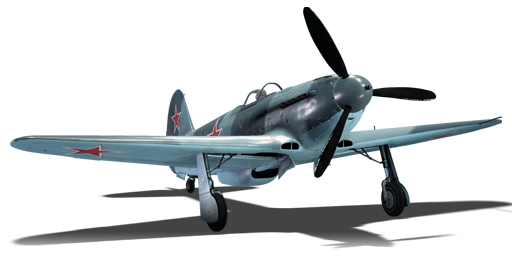



The Yakovlev Yak-3 was the first variant of the Yak-3 fighter aircraft family. The Yak 3 was one of several significant Soviet aircraft developed by Aleksandr Sergeyevich Yakovlev's Design Bureau, with development beginning in 1941 and initially centred on the new VK-107 VEE-twelve engine, with design parameters including the least possible drag, smallest dimensions, and weight consistent with a manoeuvrable and tough fighting aircraft. The design began with the I-30 prototype, presented alongside the I-26 (Yak-1) as an alternate design. The I-30 was an all-metal aircraft powered by a Klimov M-105P engine and featured a wing with dihedral on the outer panels. While the I-26 continued into production as the Yak-1, it was realised during the Battle of Stalingrad that the design was greatly in need of modernisation. Thus, Yakovlev returned to the I-30 prototype, incorporating new design elements inspired by the Yak-1, eventually producing the Yak-3. The Yak-3 did not reach actual duty until July 1944, but it quickly proved to be a superb handling aircraft at heights of up to 4,000 m, astonishing its pilots with its ability. Since the VK-107 VEE-twelve engine was unavailable, the Yak 1's VK-105 engine was used instead. A total of 4,848 aircraft were produced, gaining significant success against German fighters in the latter stages of World War II and, when eventually upgraded with the 1,700 hp VK-107A engine in late 1944 (Yak-3 (VK-107)), achieved a speed of 720 km/h at 6,000 m. The fastest Yak-3 variant, powered by the VK-108 engine, initially flew on December 9, 1944, reaching 745 km/h.
Introduced in the Open Beta Test prior to Update 1.27, the Yak-3 has an excellent combination of speed, manoeuvrability, and firepower. As one of the most powerful and lethal Yak fighter aircraft, it can truly shine in the hands of a skilled pilot. Despite being a "jack-of-all-trades, master-of-none" aircraft, it is one of the greatest Yak fighter aircraft with excellent low-altitude performance that will undoubtedly make opponents struggle if played to its strengths. Traditional Yak fighter aircraft tactics should still be used with the Yak-3. It is always vital to climb and try to gain some altitude, but not too much, as this would cause the performance to suffer. Few adversary fighters, even ones with substantially higher top speeds, can match Yak-3's speed below 2,000 m. It has superb turning capabilities and can closely match some Spitfires in its ranks with well-timed use of flaps. Overall, the Yak-3 can easily generate and retain energy, allowing it to maintain prolonged turn fights and vertical loops, as well as escape confrontations by maintaining dive speed if necessary.
flaps
flaps
flaps
brake
| Belt | Belt filling | Armor penetration (mm) at a distance: | |||||
|---|---|---|---|---|---|---|---|
| 10 m | 100 m | 500 m | 1000 m | 1500 m | 2000 m | ||
| FI-T/AP-I | 28 | 24 | 14 | 7 | 4 | 2 | |
| FI-T/HEF/AP-I/FI-T | 28 | 24 | 14 | 7 | 4 | 2 | |
| HEF/FI-T/AP-I | 28 | 24 | 14 | 7 | 4 | 2 | |
| FI-T | 3 | 3 | 3 | 3 | 3 | 3 | |
| AP-I/FI-T/AP-I/AP-I | 28 | 24 | 14 | 7 | 4 | 2 | |
| AP-I/HEF/HEF/FI | 28 | 24 | 14 | 7 | 4 | 2 | |
| Belt | Belt filling | Armor penetration (mm) at a distance: | |||||
|---|---|---|---|---|---|---|---|
| 10 m | 100 m | 500 m | 1000 m | 1500 m | 2000 m | ||
| T/AP/AP/IAI | 32 | 30 | 22 | 15 | 11 | 7 | |
| AP-I/API-T/IAI/IAI | 29 | 27 | 20 | 13 | 9 | 6 | |
| API-T/AP-I/AP-I/IAI | 29 | 27 | 20 | 13 | 9 | 6 | |
| AP-I(c)/AP-I/AP-I/API-T/IAI | 34 | 32 | 24 | 17 | 12 | 8 | |
| API-T | 29 | 27 | 20 | 13 | 9 | 6 | |
| AP-I/AP-I/IAI | 29 | 27 | 20 | 14 | 9 | 6 | |












Flight performance | |
|---|---|
Survivability |
|---|
Weaponry |
|---|